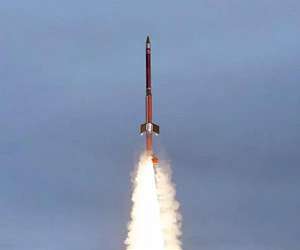Micrometeorites are a potential hazard for any space mission, including NASA’s Mars Sample Return. The tiny rocks can travel up to 50 miles per second. At these speeds, “even dust could cause damage to a spacecraft,” said Bruno Sarli, NASA engineer at NASA’s Goddard Space Flight Center, Greenbelt, Maryland.
Sarli leads a team designing shields to protect NASA’s Mars Earth Entry System from micrometeorites and space debris. Recently, he traveled to a NASA lab, designed to safely recreate dangerous impacts, to test the team’s shields and computer models.
Set far away from residents and surrounded by dunes, the Remote Hypervelocity Test Laboratory at NASA’s White Sands Test Facility in Las Cruces, New Mexico, has supported every human spaceflight program from the Space Shuttle to Artemis. The lab also supports testing for the International Space Station, Commercial Crew, and Commercial Resupply programs.
The lab uses 2-stage light gas guns to accelerate objects to speeds that simulate micrometeorite and orbital debris impacts on spacecraft shielding. The first stage uses gun powder as a propellent the way a standard gun does. The second stage uses highly compressed hydrogen gas that pushes gas into a smaller tube, increasing pressure in the gun, like a car piston. The gun’s pressure gets so high that it would level the building if it were to explode. “That is why we hung out in the bunker during the test,” said Sarli.
Engineers spent three days preparing for a one-second experiment. They used the lab’s mid-sized high-pressure (50-caliber range) 2-stage light gas gun that shoots small pellets 16 to 22 feet per second. “At that speed, you could travel from San Francisco to New York in five minutes,” said Dennis Garcia, the .50-caliber test conductor at White Sands.
While the pellet’s speed is fast, micrometeorites travel six to seven times faster in space. As a result, the team relies on computer models to simulate the actual velocities of micrometeorites. The slower rate will test their computer model’s ability to simulate impacts on their shield designs and allows the team to study the material reaction to such energy.
Mars Sample Return is a multi-mission campaign designed to retrieve scientifically selected samples of rock and sediment that the Perseverance rover is collecting on the surface of Mars. Bringing those samples to Earth would allow scientist to study them using the most advance laboratory instruments-those that will exist in the coming decade and those in the decades to follow.
The campaign is one of the most ambitious endeavors in spaceflight history, involving multiple spacecraft, multiple launches, and multiple government agencies. Goddard is currently designing and developing the Capture, Containment, and Return System that would deliver the Mars sample tubes back to Earth.
Related Links
NASA Remote Hypervelocity Test Laboratory
Rocket Science News at Space-Travel.Com
|
We need your help. The SpaceDaily news network continues to grow but revenues have never been harder to maintain. With the rise of Ad Blockers, and Facebook – our traditional revenue sources via quality network advertising continues to decline. And unlike so many other news sites, we don’t have a paywall – with those annoying usernames and passwords. Our news coverage takes time and effort to publish 365 days a year. If you find our news sites informative and useful then please consider becoming a regular supporter or for now make a one off contribution. |
||
|
SpaceDaily Monthly Supporter $5+ Billed Monthly |
SpaceDaily Contributor $5 Billed Once credit card or paypal |
|

![]()
Successful TEXUS 57 Launch – the weightless world above the Arctic Circle
Kiruna, Sweden (SPX) Oct 07, 2022
The TEXUS 57 sounding rocket was successfully launched on the first launch attempt on 1 October at 08:26 local time (06:26 UTC) from the Esrange Space Centre in Sweden to enable microgravity experiments in space. What is behind this long-lasting programme and what is its contribution to scientific research?
TEXUS (Technological Experiments in Zero Gravity) is the world’s most successful and longest lasting sounding rocket programme – the first TEXUS rocket launched in December 1977. Sounding rocke … read more